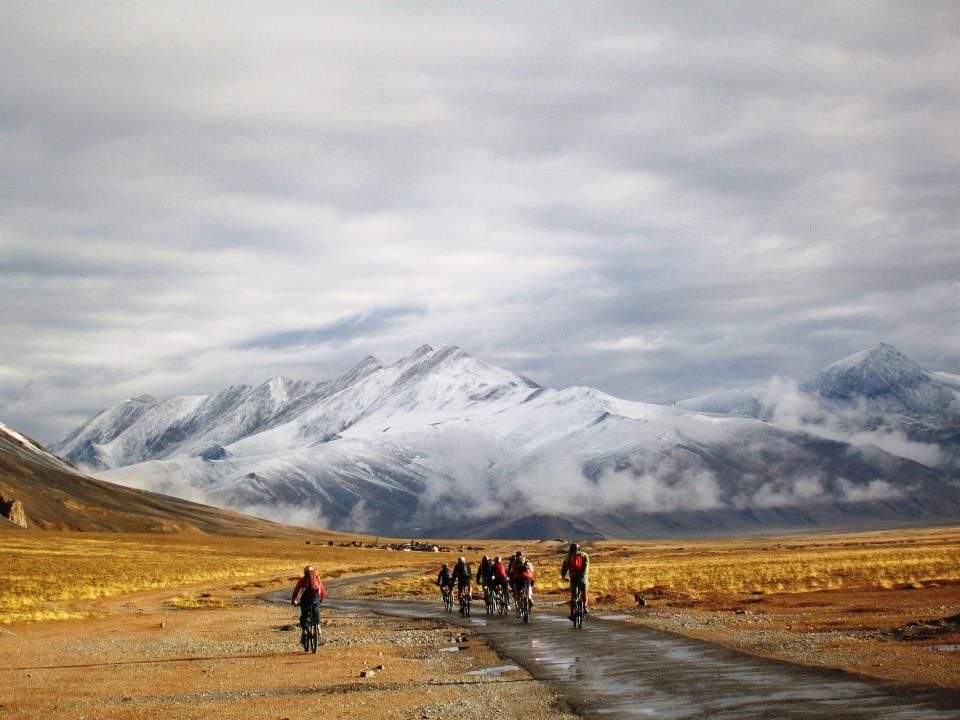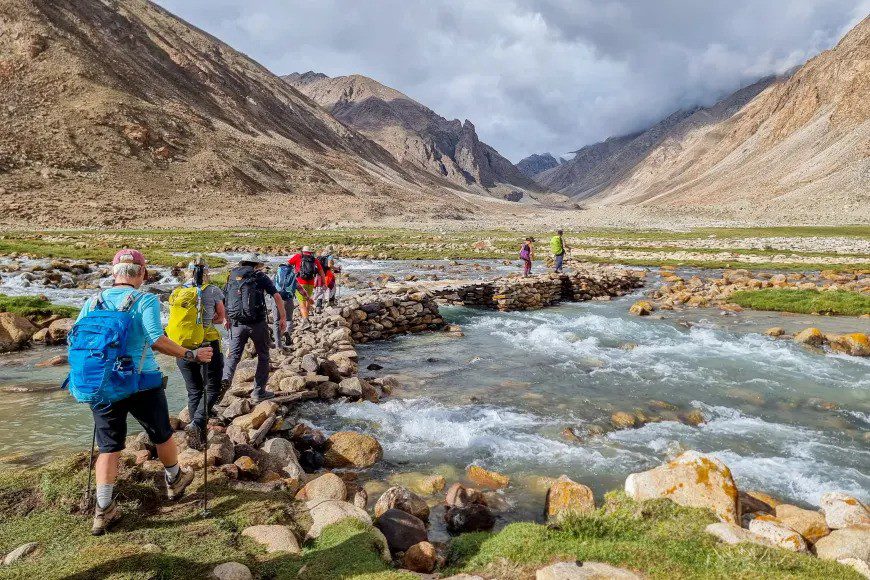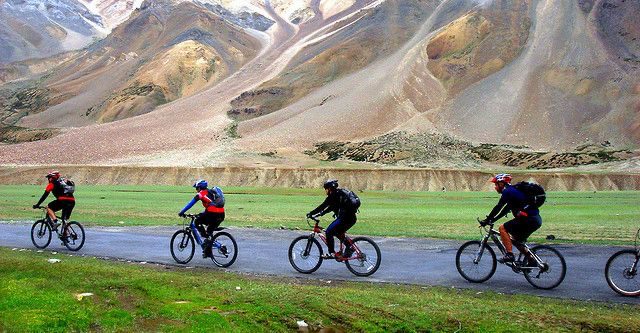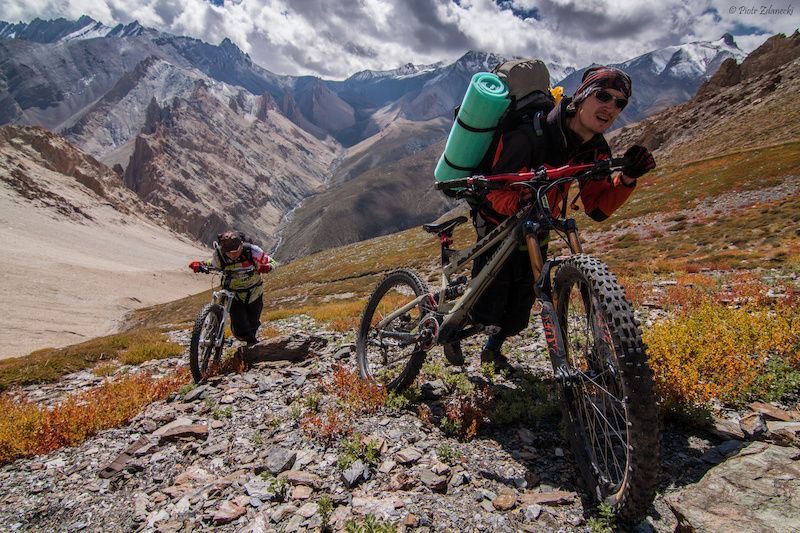Ladakh, the “Land of High Passes,” is a remote and mesmerizing region in the Indian Himalayas, perfect for adventure enthusiasts. Combining biking and trekking in Ladakh provides an unforgettable experience, offering breathtaking landscapes, cultural immersion, and physical challenges. From riding your bike over the world’s highest motorable passes to trekking through remote valleys and majestic peaks, Ladakh offers it all. This guide covers everything you need to know to plan and enjoy this epic dual adventure.
Why Ladakh is the Ultimate Destination for Adventure Enthusiasts
The Unique Terrain of Ladakh
Ladakh’s terrain is like no other, with its rugged mountains, vast plateaus, and deep valleys creating the perfect playground for both biking and trekking. As you travel through the region, you’ll cross high-altitude passes, ride along winding roads, and trek through some of the most scenic and remote trails in the world.
The variety of terrains—from the Zanskar Valley’s ruggedness to the smoother routes around Pangong Lake—ensures that every biker and trekker finds their perfect challenge. Adventure tourism in Ladakh has seen a rise due to its unique geography, making it a prime spot for explorers.
“The landscape of Ladakh is just otherworldly. We biked through valleys surrounded by towering peaks and trekked across rivers. This place pushes your limits but rewards you with views you’ll never forget.”
— John Matthews, Photographer, USA
Best Time to Experience Biking and Trekking in Ladakh
The best time for biking and trekking in Ladakh is between June and September. During this period, the weather is milder, the roads are open, and the trekking trails are accessible. Snow melts from the high-altitude passes, allowing bikers to take on the thrilling Manali to Leh bike trip or the Khardung La ride.
Planning your trip during these months also ensures you avoid the harsh winter conditions, when temperatures drop dramatically, and many roads become impassable due to snow.

Popular Biking Routes in Ladakh
Manali to Leh Bike Trip: The Ultimate Challenge
The Manali to Leh bike trip is an iconic journey and a rite of passage for adventure bikers. Spanning over 475 km, this route takes you through some of the most stunning landscapes in India, including Rohtang Pass, Baralacha La, and Tanglang La. The ride offers a mix of challenging terrain, high-altitude passes, and awe-inspiring views.
This route is ideal for those looking to combine biking with short trekking stops, especially around the Zing Zing Bar and Sarchu regions, where you can explore lesser-known trails on foot.
“Riding from Manali to Leh was the most exhilarating experience of my life. The high passes, the changing landscapes, and the sense of adventure were unmatched. We also took a short trek near Sarchu, which gave us a chance to experience Ladakh’s raw beauty up close.”
— Rajesh Sharma, IT Professional, India
Biking Across Khardung La Pass
At 5,359 meters (17,582 feet), Khardung La is often considered the highest motorable road in the world. The ride to this legendary pass is challenging due to the thin air and steep ascent, but it’s a must-do for biking enthusiasts visiting Ladakh. The road offers stunning views of the Nubra Valley, and once you conquer the pass, you can head into the valley to explore its many trekking routes.
This is where biking and trekking in Ladakh merge beautifully, as you can combine the thrilling bike ride with treks in Nubra, such as the Diskit to Hunder route.
Leh to Pangong Lake: A Scenic Ride
The ride from Leh to Pangong Lake is both scenic and rewarding, passing through Chang La Pass, another high-altitude challenge. Pangong Lake, one of the highest saltwater lakes in the world, is known for its stunning blue waters. Many bikers choose to combine this ride with short hikes around the lake, adding a more intimate connection with the natural beauty of the region.
For an added adventure, you can extend your trek to explore nearby valleys and remote villages like Merak and Spangmik.
Unforgettable Trekking Routes in Ladakh
Markha Valley Trek: A Trekker’s Paradise
The Markha Valley trek is arguably the most popular trek in Ladakh. This moderate-to-difficult trek offers stunning views of the Zanskar Range and takes you through remote villages like Hankar and Skiu. Combining biking with the Markha Valley trek offers an unparalleled adventure.
The trek typically starts from Spituk or Chilling, and for those who love biking, starting the journey with a bike ride from Leh to Chilling adds an exciting dimension to the trip.
“We biked from Leh to Chilling and then switched to trekking mode for the Markha Valley. The mix of biking and trekking was exhausting but so rewarding. I felt like we saw the best of Ladakh in just a week.”
— Alyssa Reid, Teacher, Canada
Nubra Valley Trek: Discover Remote Villages
The Nubra Valley is well-known for its sand dunes and remote monasteries, but it’s also home to some of the best trekking routes in Ladakh. After riding over Khardung La, many travelers choose to explore Nubra on foot, trekking from Diskit to Turtuk or hiking through the Sumur region. This valley offers a unique mix of desert landscapes and lush greenery, making the trek one-of-a-kind.

Combining a Khardung La bike ride with trekking in Nubra is a perfect way to experience Ladakh’s diversity.
Stok Kangri Trek: Reaching Ladakh’s Highest Peak
For seasoned adventurers, the Stok Kangri trek is a must. Standing at 6,153 meters (20,187 feet), it is one of the highest trekking peaks in India and offers panoramic views of the Himalayas. Although the trek is challenging, it can be combined with a biking journey through Leh and the Indus Valley, making for an epic adventure.
Combining Biking and Trekking: An Adventure Like No Other
Planning a Dual Adventure in Ladakh
Planning to combine biking and trekking in Ladakh requires careful consideration of your route, timing, and fitness level. Adventurers often start with biking routes like Manali to Leh or Leh to Khardung La and then switch to trekking in regions like the Markha Valley or Nubra Valley.
Combining these activities allows you to cover more ground, see different sides of Ladakh, and experience the region’s beauty from both the seat of a bike and the comfort of your hiking boots.
Essential Gear for Both Biking and Trekking
Due to the rugged terrain and high-altitude conditions, it’s essential to pack the right gear for both biking and trekking. Key items include:
- High-quality mountain bike with thick tires
- Trekking poles for added stability on uneven ground
- Breathable clothing suitable for high-altitude conditions
- Altitude sickness medication
- Lightweight tent for camping during treks
- Hydration packs and energy bars for long days
“Packing light but smart was crucial. We were biking at high altitudes one day and trekking the next. Having the right gear made all the difference in staying comfortable and safe.”
— David Lopez, Adventure Blogger, Spain
Physical Fitness and Altitude Challenges
Combining biking and trekking in Ladakh requires a good level of physical fitness due to the demanding terrain and high altitudes. Altitude sickness can be a real concern when biking over passes like Khardung La or trekking near Stok Kangri, so it’s important to take it slow, acclimatize properly, and stay hydrated.

Cultural and Scenic Highlights Along Ladakh’s Trails
Discovering Ladakh’s Remote Villages
One of the highlights of biking and trekking through Ladakh is the opportunity to visit remote villages like Hunder, Sakti, and Spituk. Here, you’ll meet friendly locals, witness traditional Ladakhi life, and visit centuries-old monasteries. These cultural experiences enrich your adventure, offering a deeper connection to the region.
Stunning Landscapes Along the Way
Whether you’re biking through the winding roads of Zanskar Valley or trekking through the colorful mountains of Markha, the landscapes in Ladakh are nothing short of breathtaking. From snow-capped peaks to deep gorges, every twist and turn reveals a new and stunning view.

FAQs About Biking and Trekking in Ladakh
What is the best time to combine biking and trekking in Ladakh?
The best time to combine biking and trekking in Ladakh is from June to September, when the weather is optimal, and the roads and trails are accessible.
Do I need special permits for biking and trekking in Ladakh?
Yes, certain areas like Nubra Valley and Pangong Lake require Inner Line Permits for both biking and trekking.
How should I prepare for the high altitudes in Ladakh?
Spend a few days in Leh to acclimatize before starting your adventure. Drink plenty of water, avoid alcohol, and don’t rush into high-altitude biking or trekking.
What are the most popular biking and trekking routes in Ladakh?
Popular biking routes include Manali to Leh and Leh to Pangong Lake. For trekking, the Markha Valley and Stok Kangri treks are top choices.
How physically fit do I need to be for Ladakh adventures?
A good level of fitness is required, as the combination of biking and trekking can be physically demanding, especially in high-altitude areas.
Can beginners enjoy biking and trekking in Ladakh?
Yes, beginners can enjoy the adventure, but it’s important to choose less challenging routes and take time to acclimatize properly.
Conclusion: Embrace the Thrill of Biking and Trekking in Ladakh
Ladakh offers the perfect combination of biking and trekking, providing adventure enthusiasts with the opportunity to explore its majestic landscapes and rich culture. Whether you’re conquering Khardung La on your bike or trekking through the serene Markha Valley, Ladakh promises a journey filled with excitement and unforgettable memories.
Biking and Trekking in Ladakh
Biking and Trekking in Ladakh | The journey through Ladakh mirrors the very essence of unraveling unknown horizons, as its dramatic landscapes and unique cultural identity awaken the deepest sense of wonder and exploration. Biking and Trekking in Ladakhdelves into this realm where inner peace intertwines with the wild, untouched beauty of Ladakh. From the snow-capped peaks to the serene monasteries, every step in Ladakh is a step toward self-discovery. The mountains, ancient paths, and unspoken mysteries stretch before travelers, offering a meditative experience where each encounter feels both effortless and transformative. Whether it’s trekking across remote valleys or sitting quietly beside a sacred lake, Ladakh invites those who seek a deeper connection to the natural and spiritual world.

The Biking and Trekking in Ladakh’s Biking and Trekking in Ladakh
The monasteries of Ladakh stand as living monuments to the region’s profound spiritual heritage. With origins dating back over a thousand years, these ancient structures are both places of worship and repositories of art, culture, and wisdom. Hemis Monastery, one of the largest in Ladakh, is renowned for its annual festival, featuring colorful mask dances performed by monks. The history of these monasteries reflects Ladakh’s role as a crossroads between India, Tibet, and Central Asia, where religious and cultural influences have intertwined over the centuries.
The Tibetan Buddhist influence is especially evident in the architecture and daily life of the monks. Prayer wheels, intricate murals, and the soft hum of chants fill the air as visitors explore the monastery grounds. Each monastery, from the remote Lamayuru to the awe-inspiring Thiksey, offers a window into the spiritual heart of Ladakh. These centers of meditation, learning, and community life continue to thrive, preserving traditions that have shaped Ladakh for generations.
Why Visit Ladakh for Biking and Trekking in Ladakh?
Ladakh is a destination that transcends mere travel. It offers a journey that touches both the outer and inner landscapes, making it a perfect setting for those who seek to unravel their own unknown horizons. The region’s breathtaking scenery—from towering mountain ranges to hidden valleys—provides not just an escape but a space for contemplation and growth. Ladakh’s culture, deeply rooted in Buddhist practices, invites visitors to reflect on their own lives and the world around them.
Ladakh’s people, known for their warmth and hospitality, add to the richness of the experience. Villages like Sumda Chun and the legendary Nubra Valley introduce travelers to a way of life that is intricately connected to nature and spirituality. Staying in local homestays allows for immersive experiences where one can learn about traditional Ladakhi customs, share meals made from local produce, and participate in community rituals.

Beyond its natural beauty, Ladakh offers a unique opportunity to explore oneself. The vastness of the region’s plateaus and the clarity of its skies seem to mirror the vastness of the human spirit. Whether it’s standing atop a mountain pass at 18,000 feet or meditating in a centuries-old monastery, Ladakh helps unravel the unknown horizons within each traveler.
Finding the Best Biking and Trekking in Ladakh in Ladakh
Finding the best places in Ladakh to experience “Biking and Trekking in Ladakh” involves venturing off the beaten path. Ladakh’s lesser-known treks, such as those leading to secluded monasteries or high-altitude lakes, offer unparalleled opportunities for solitude and reflection. The Markha Valley trek, for instance, takes travelers through verdant valleys, ancient villages, and high-altitude passes, allowing for both physical and spiritual exploration.
Ladakh’s iconic lakes, including Pangong Tso and Tso Moriri, are ideal spots for quiet contemplation. Their still waters reflect the sky, creating a mesmerizing landscape that feels timeless and infinite. Sitting beside these lakes, especially at dawn or dusk, brings an overwhelming sense of peace and connection with nature.

For those interested in Ladakh’s spiritual heritage, exploring monasteries such as Alchi, Phyang, or Diskit can be a transformative experience. These sites are not just places of worship but also centers of art, philosophy, and wisdom. Visiting these monasteries, with their ancient murals and intricate statues, offers insight into Ladakh’s rich cultural tapestry.
Ladakh’s Atmosphere and Biking and Trekking in Ladakh
Ladakh’s atmosphere is unlike any other place on Earth. The stark contrasts between the rugged mountains and the serene, tranquil monasteries create an environment that feels both raw and sacred. The traditional decor in Ladakhi homes and religious sites reflects this balance, with mud-brick houses adorned with prayer flags and colorful thangkas (Buddhist paintings) that add warmth and spiritual meaning to the space.

The interiors of Ladakhi homes, often simple and functional, are filled with symbols of devotion. Small shrines dedicated to Buddhist deities are common, and the air is often fragrant with incense. The use of earthy materials, like stone and wood, along with brightly colored textiles, creates an inviting and peaceful space, perfect for relaxation and reflection.
Traditional Ladakhi Cuisine
Traditional Ladakhi cuisine is an integral part of the region’s identity, offering a unique blend of flavors that reflect its harsh climate and remote location. Hearty, warming dishes such as thukpa (noodle soup) and momos (dumplings) provide the sustenance needed to endure Ladakh’s cold temperatures. Skyu, a thick stew made with root vegetables and barley, is another staple of the Ladakhi diet, designed to nourish both body and spirit.

Drinks like butter tea, made with yak butter and salt, are a must-try for anyone visiting Ladakh. This rich, savory drink is not only warming but also hydrating, making it essential for those venturing into the high-altitude regions of Ladakh. Chang, a local barley beer, is often enjoyed during festivals and community gatherings, adding a sense of joy and camaraderie to any occasion.
Live Cultural Biking and Trekking in Ladakh in Ladakh
Ladakh is home to a vibrant cultural scene, with festivals and live performances held throughout the year. The Hemis Festival, which celebrates the birth of Guru Padmasambhava, is one of the largest and most famous events in the region. Monks dressed in elaborate costumes perform cham dances, which depict the triumph of good over evil. The energy of the festival, with its bright colors, rhythmic music, and elaborate rituals, draws visitors from around the world.
Other local festivals, such as the Losar (New Year) and Ladakh Festival, provide visitors with the chance to witness traditional dance, music, and crafts that have been passed down through generations. These events are more than just entertainment; they are a celebration of Ladakh’s rich cultural heritage and its deep connection to the spiritual world.
Trekking and Outdoor Activities Biking and Trekking in Ladakh
Ladakh is a trekker’s paradise, offering some of the most stunning and challenging routes in the world. From the famous Biking and Trekking in Ladakh, which follows the frozen Zanskar River, to lesser-known routes like the Sham Valley or Nubra Valley treks, Ladakh’s landscape offers endless possibilities for adventure and discovery. The high-altitude passes, such as Khardung La and Chang La, offer breathtaking views of snow-capped peaks and sprawling valleys.

Wildlife enthusiasts will also find Biking and Trekking in Ladakh to be a haven for rare species such as the snow leopard, Himalayan blue sheep, and the Tibetan wild ass. Winter expeditions to spot the elusive snow leopard in the Hemis National Park are gaining popularity among wildlife photographers and conservationists alike.
The Importance of Preserving Ladakh’s Biking and Trekking in Ladakh
Ladakh’s rich cultural and environmental Biking and Trekking in Ladakh is under increasing threat from climate change and mass tourism. Preserving this unique region requires careful attention to sustainable tourism practices. Choosing eco-friendly accommodations, supporting local businesses, and participating in community-led conservation efforts are just a few ways that visitors can contribute to the preservation of Ladakh’s natural and cultural heritage.
Ladakh’s people have a long history of living in harmony with their environment, practicing sustainable agriculture, and maintaining a deep spiritual connection to the land. Visitors are encouraged to follow the same principles, leaving no trace and respecting the fragile ecosystems that make Ladakh so special.
Etiquette and Tips for Visiting Biking and Trekking in Ladakh
Before visiting Ladakh, it’s essential to understand and respect the region’s customs and traditions. As a deeply spiritual place, Ladakh requires visitors to dress modestly, especially when visiting monasteries or attending religious ceremonies. Always ask for permission before taking photographs inside monasteries or of local people.
Medical Biking and Trekking in Ladakh
Spa trail Biking and Trekking in Ladakh
Biking and Trekking in Ladakh

When Biking and Trekking in Ladakh, remember to stay on designated paths to avoid damaging fragile ecosystems. Tipping is appreciated but not expected in most settings, and it’s important to carry cash, as many remote areas do not accept credit cards. Lastly, be mindful of altitude sickness and take the necessary precautions when traveling to higher elevations.
Conclusion: Enjoying Biking and Trekking in Ladakh in Ladakh
Ladakh is a place where the physical and spiritual worlds converge, offering travelers a journey unlike any other. Whether you’re trekking across high-altitude deserts, exploring ancient monasteries, or simply sitting in quiet reflection by a mountain lake, Ladakh invites you to unravel your own unknown horizons. By respecting the region’s traditions and practicing sustainable tourism, you help ensure that Ladakh’s beauty and cultural richness will be preserved for future generations to explore and enjoy.












